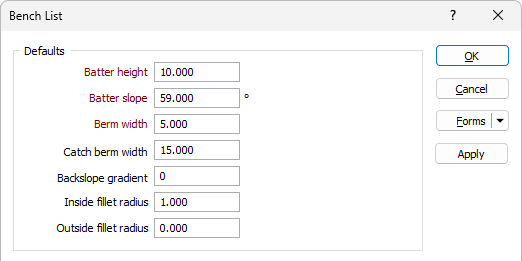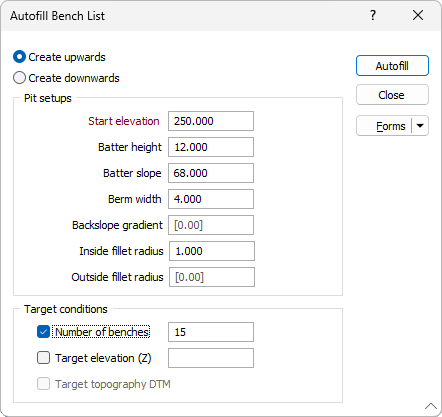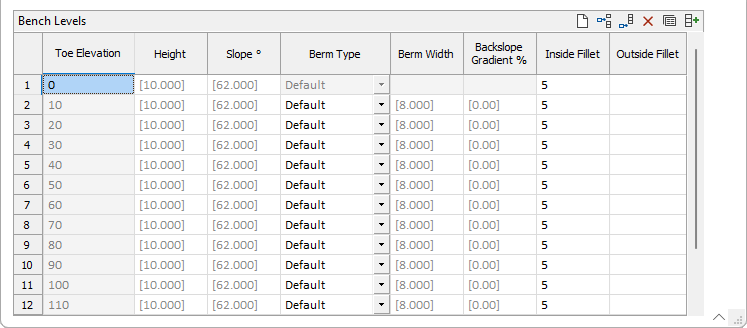Bench List
the Mining | Pit Design tab, in the Parameters group: Click Bench List to display the Bench List defaults and list of Benches in the pit design.
![]()
Defaults

Batter height
After the initial cut the Bench will present a face, and at this stage a bench can also be called a Batter.
Batter height is the vertical distance between Toe and Crest of the bench or the vertical distance between the upper surface of the bench and the lower (floor) surface of the bench. It is the Batters that form the final pit limits.
A "bench', on the other hand, is an operational open-pit concept. Pits are mined by benches, this is the unit of reference for extraction. A bench has an upper and lower surface. It can be described as a tabular body with a specific thickness called Bench Height. When benches achieve the final pit limit they form a pit 'batter'.
Batter slope
The Batter slope is the default angle, measured from the horizontal, between successive toe and crest strings. The angle is measured in degrees to 2 decimal places and the angle value should be greater than 0 and less than 90.
Berm width
The Berm width is the horizontal distance between a toe and a corresponding crest at the same level.
Berm Width is used to define the required width between bench faces. It is the measurement from the toe of the upper bench to the Crest of the lower Bench. Berms are necessary to provide slope stability and other safety reasons.
Catch Berm Width
Enter the width of the default width of the catch berms throughout the design.
Ramp Gradient Unit
The ramp gradient unit is the unit of measurement for the gradients of elements such as roads, ramps, switchbacks in your design. Use the drop down list to select the default Ramp Gradient unit:

Backslope Gradient
Sometimes a slope may need to be designed into the berms in order to collect water or stone fragments against the pit wall.
Enter a Backslope Gradient value. The value you enter should fall between 1% and 30% (typically 5 or 10) %.
If your configured gradient unit is not percent, the value you enter will be capped to the values converted into those units that are equal to 1%-30%.
Inside fillet radius
Optionally enter an Inside fillet radius to condition the resultant pit strings. Fillets are applied to angles on the pit strings which range from acute to obtuse. The Inside fillet radius value applies filleting to angles on the inside of the string perimeters.
Outside fillet radius
Optionally enter an Outside fillet radius to condition the resultant pit strings. Fillets are applied to angles on the pit strings which range from acute to obtuse. The Outside fillet radius value applies filleting to angles on the outside of the string perimeters.
Benches
The Bench Levels grid displays a list of the benches in the current pit design
To populate the bench list, you can use the buttons in the toolbar to manually enter rows, or select the Autofill the Grid button to open the Autofill Bench List form:

Create Upwards / Downwards
Select whether to create the benches for the pit upwards or downwards.
Pit Setups
Start elevation
Enter the elevation of the bottom string (toe) for the first bench in the pit projection. The remaining benches, if any, will be auto-assigned the elevation based on the start.
Batter height
After the initial cut the Bench will present a face, and at this stage a bench can also be called a Batter.
Batter height is the vertical distance between Toe and Crest of the bench or the vertical distance between the upper surface of the bench and the lower (floor) surface of the bench. It is the Batters that form the final pit limits.
A "bench', on the other hand, is an operational open-pit concept. Pits are mined by benches, this is the unit of reference for extraction. A bench has an upper and lower surface. It can be described as a tabular body with a specific thickness called Bench Height. When benches achieve the final pit limit they form a pit 'batter'.
Batter slope
The Batter slope is the default angle, measured from the horizontal, between successive toe and crest strings. The angle is measured in degrees to 2 decimal places and the angle value should be greater than 0 and less than 90.
Berm width
The Berm width is the horizontal distance between a toe and a corresponding crest at the same level.
Berm Width is used to define the required width between bench faces. It is the measurement from the toe of the upper bench to the Crest of the lower Bench. Berms are necessary to provide slope stability and other safety reasons.
Ramp Gradient Unit
The ramp gradient unit is the unit of measurement for the gradients of elements such as roads, ramps, switchbacks in your design. Use the drop down list to select the default Ramp Gradient unit:

Backslope Gradient
Sometimes a slope may need to be designed into the berms in order to collect water or stone fragments against the pit wall.
Enter a Backslope Gradient value. The value you enter should fall between 1% and 30% (typically 5 or 10) %.
If your configured gradient unit is not percent, the value you enter will be capped to the values converted into those units that are equal to 1%-30%.
Inside fillet radius
Optionally enter an Inside fillet radius to condition the resultant pit strings. Fillets are applied to angles on the pit strings which range from acute to obtuse. The Inside fillet radius value applies filleting to angles on the inside of the string perimeters.
Outside fillet radius
Optionally enter an Outside fillet radius to condition the resultant pit strings. Fillets are applied to angles on the pit strings which range from acute to obtuse. The Outside fillet radius value applies filleting to angles on the outside of the string perimeters.
Target Conditions
The Target Conditions options determine the desired values of the output; including number of benches, elevation and topography.
Number of benches
Select this option to project the pit up or down by the required number of benches.
Target elevation (Z)
Select this option to project the pit up or down until it reaches a target elevation.
Target Topography DTM
Select this option to project the pit up or down until it fully penetrates the surface of the topography DTM configured in Setup.
When the details for the bench list have been configured in the Auto Build Pit form, click the Autofill button to populate the Bench List grid.
Bench Levels Grid

The Bench Levels grid contains the following values for each bench in the list :
|
Toe Elevation |
The elevation of the inside peak formed by the intersection of the bench face and bench floor. |
|
Height |
The height in grid units for the bench. |
|
Slope ° |
The degree value of the slope for the bench. The default is 45°. |
|
Berm Type |
The berm type for the bench - Default, Catch or None. |
|
Berm Width |
The width in grid units of the selected berm type for the bench. The default value is 10. Berm Width is used to define the required width between bench faces. It is the measurement from the toe of the upper bench to the Crest of the lower Bench. Berms are necessary to provide slope stability and other safety reasons. |
|
Backslope Gradient % |
The gradient percentage of the backslope for the bench, if any. |
| Inside Fillet | The inside fillet radius of the bench, if any. Fillets are applied to angles on the pit strings which range from acute to obtuse. The Inside fillet radius value applies filleting to angles on the inside of the string perimeters. |
| Outside Fillet | The outside fillet radius of the bench, if any. Fillets are applied to angles on the pit strings which range from acute to obtuse. The Outside fillet radius value applies filleting to angles on the outside of the string perimeters. |
Forms
Click the Forms button to select and open a saved form set, or if a form set has been loaded, save the current form set.